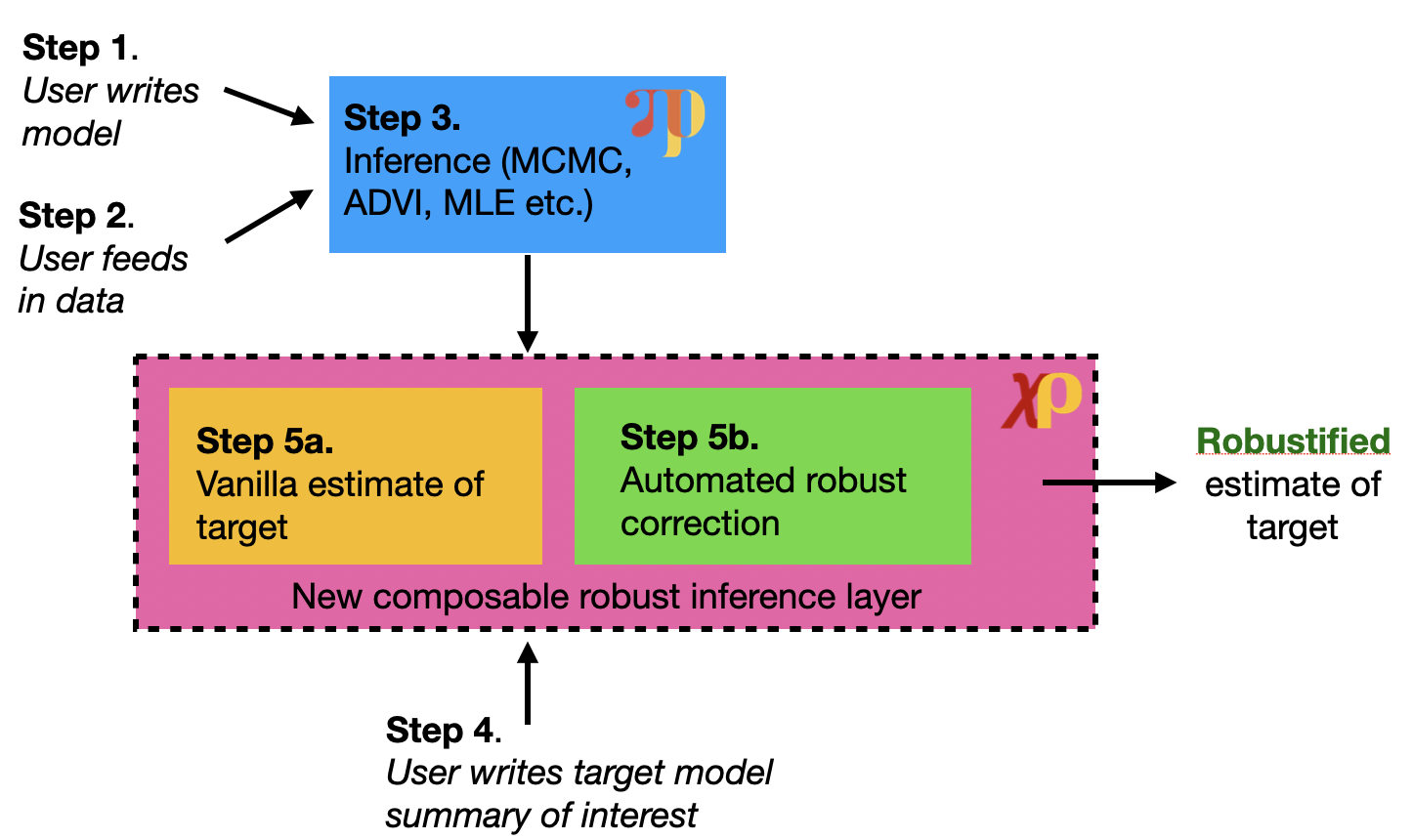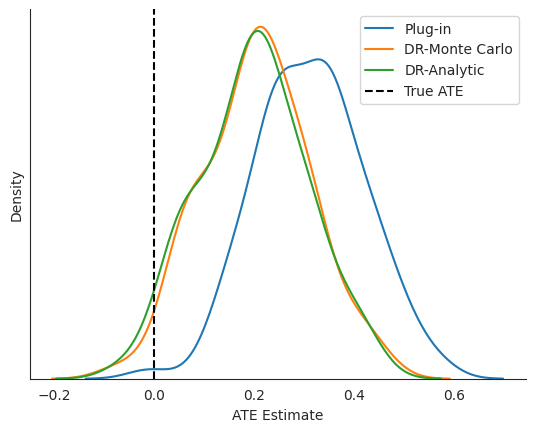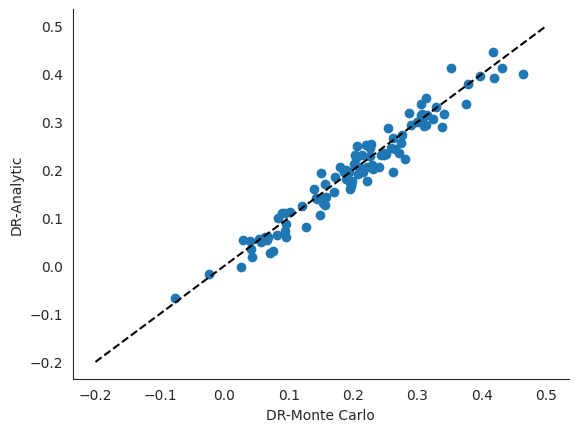Automated doubly robust estimation with ChiRho¶
Setup¶
Here, we install the necessary Pytorch, Pyro, and ChiRho dependencies for this example.
[1]:
from typing import Callable, Optional, Tuple
import functools
import torch
import math
import seaborn as sns
import pandas as pd
import numpy as np
import matplotlib.pyplot as plt
import pyro
import pyro.distributions as dist
from chirho.counterfactual.handlers import MultiWorldCounterfactual
from chirho.indexed.ops import IndexSet, gather
from chirho.interventional.handlers import do
from chirho.observational.handlers.condition import condition
from chirho.observational.handlers.predictive import PredictiveModel
from chirho.robust.handlers.estimators import MonteCarloInfluenceEstimator, one_step_corrected_estimator
if not pyro.settings.get("module_local_params"):
pyro.settings.set(module_local_params=True)
sns.set_style("white")
pyro.set_rng_seed(321) # for reproducibility
Overview: automated robust estimation pipeline¶
In this tutorial, we will use ChiRho to estimate the average treatment effect (ATE) from observational data. We will use a simple example to illustrate the basic concepts of doubly robust estimation and how ChiRho can be used to automate the process for more general summaries of interest.
There are five main steps to our doubly robust estimation procedure but only the last step is different from a standard probabilistic programming workflow:
Write model of interest
Define probabilistic model of interest using Pyro
Feed in data
Observed data used to train the model
Run inference
Use Pyro’s rich inference library to fit the model to the data
Define target functional
This is the model summary of interest (e.g. average treatment effect)
Compute robust estimate
Use ChiRho to compute the doubly robust estimate of the target functional
Importantly, this step is automated and does not require refitting the model for each new functional
Our proposed automated robust inference pipeline is summarized in the figure below.

Causal Probabilistic Program¶
Model Description¶
In this example, we will focus on a cannonical model CausalGLM consisting of three types of variables: binary treatment (A), confounders (X), and response (Y). For simplicitly, we assume that the response is generated from a generalized linear model with link function \(g\). The model is described by the following generative process:
where \(p\) denotes the number of confounders, \(\pi(X)\) is the probability of treatment conditional on confounders \(X\), \(\beta_0\) is the intercept, \(\beta_1\) is the confounder effect, and \(\tau\) is the treatment effect.
[2]:
class CausalGLM(pyro.nn.PyroModule):
def __init__(
self,
p: int,
link_fn: Callable[..., dist.Distribution] = lambda mu: dist.Normal(mu, 1.0),
prior_scale: Optional[float] = None,
):
super().__init__()
self.p = p
self.link_fn = link_fn
if prior_scale is None:
self.prior_scale = 1 / math.sqrt(self.p)
else:
self.prior_scale = prior_scale
@pyro.nn.PyroSample
def outcome_weights(self):
return dist.Normal(0.0, self.prior_scale).expand((self.p,)).to_event(1)
@pyro.nn.PyroSample
def intercept(self):
return dist.Normal(0.0, 1.0)
@pyro.nn.PyroSample
def propensity_weights(self):
return dist.Normal(0.0, self.prior_scale).expand((self.p,)).to_event(1)
@pyro.nn.PyroSample
def treatment_weight(self):
return dist.Normal(0.0, 1.0)
@property
def covariate_loc(self):
return torch.zeros(self.p)
@property
def covariate_scale(self):
return torch.ones(self.p)
def forward(self):
X = pyro.sample("X", dist.Normal(self.covariate_loc, self.covariate_scale).to_event(1))
A = pyro.sample(
"A",
dist.Bernoulli(
logits=torch.einsum("...i,...i->...", X, self.propensity_weights)
),
)
return pyro.sample(
"Y",
self.link_fn(
torch.einsum("...i,...i->...", X, self.outcome_weights) + A * self.treatment_weight + self.intercept
),
)
Next, we will condition on both treatment and confounders to estimate the causal effect of treatment on the outcome. We will use the following causal probabilistic program to do so:
[3]:
class ConditionedModel(CausalGLM):
def forward(self, *, X: torch.Tensor, A: torch.Tensor, Y: torch.Tensor):
with condition(data={"X": X, "A": A, "Y": Y}):
self.intercept, self.outcome_weights, self.propensity_weights, self.treatment_weight
with pyro.plate("__train__", size=X.shape[0], dim=-1):
return super().forward()
[4]:
# Visualize the model
pyro.render_model(
lambda: ConditionedModel(p=1)(X=torch.zeros(1, 1), A=torch.zeros(1), Y=torch.zeros(1)),
render_params=True,
render_distributions=True
)
[4]:
Generating data¶
For evaluation, we generate N_datasets datasets, each with N samples. We compare vanilla estimates of the target functional with the double robust estimates of the target functional across the N_sims datasets. We use a similar data generating process as in Kennedy (2022).
[5]:
class GroundTruthModel(CausalGLM):
def __init__(
self,
p: int,
alpha: int,
beta: int,
link_fn: Callable[..., dist.Distribution] = lambda mu: dist.Normal(mu, 1.0),
):
super().__init__(p, link_fn)
self.alpha = alpha # sparsity of propensity weights
self.beta = beta # sparsity of outcome weights
@property
def outcome_weights(self):
outcome_weights = 1 / math.sqrt(self.beta) * torch.ones(self.p)
outcome_weights[self.beta :] = 0.0
return outcome_weights
@property
def propensity_weights(self):
propensity_weights = 1 / math.sqrt(self.alpha) * torch.ones(self.p)
propensity_weights[self.alpha :] = 0.0
return propensity_weights
@property
def treatment_weight(self):
return torch.tensor(0.)
@property
def intercept(self):
return torch.tensor(0.0)
[6]:
N_datasets = 100
simulated_datasets = []
# Data configuration
p = 200
alpha = 50
beta = 50
N_train = 500
N_test = 500
true_model = GroundTruthModel(p, alpha, beta)
for _ in range(N_datasets):
# Generate data
D_train = pyro.infer.Predictive(
true_model, num_samples=N_train, return_sites=["X", "A", "Y"], parallel=True
)()
D_test = pyro.infer.Predictive(
true_model, num_samples=N_test, return_sites=["X", "A", "Y"], parallel=True
)()
simulated_datasets.append((D_train, D_test))
Fit parameters via maximum likelihood¶
[7]:
trained_guides = []
for i in range(N_datasets):
# Generate data
D_train = simulated_datasets[i][0]
# Fit model using maximum likelihood
conditioned_model = ConditionedModel(p=D_train["X"].shape[1])
guide_train = pyro.infer.autoguide.AutoDelta(conditioned_model)
elbo = pyro.infer.Trace_ELBO()(conditioned_model, guide_train)
# initialize parameters
elbo(X=D_train["X"], A=D_train["A"], Y=D_train["Y"])
adam = torch.optim.Adam(elbo.parameters(), lr=0.03)
# Do gradient steps
for _ in range(2000):
adam.zero_grad()
loss = elbo(X=D_train["X"], A=D_train["A"], Y=D_train["Y"])
loss.backward()
adam.step()
trained_guides.append(guide_train)
Causal Query: Average treatment effect (ATE)¶
The average treatment effect summarizes, on average, how much the treatment changes the response, \(ATE = \mathbb{E}[Y|do(A=1)] - \mathbb{E}[Y|do(A=0)]\). The do notation indicates that the expectations are taken according to intervened versions of the model, with \(A\) set to a particular value. Note from our tutorial that this is different from conditioning on \(A\) in the original causal_model, which assumes \(X\) and \(T\) are dependent.
To implement this query in ChiRho, we define the ATEFunctional class which take in a model and guide and returns the average treatment effect by simulating from the posterior predictive distribution of the model and guide.
Defining the target functional¶
[8]:
class ATEFunctional(torch.nn.Module):
def __init__(self, model: Callable, *, num_monte_carlo: int = 100):
super().__init__()
self.model = model
self.num_monte_carlo = num_monte_carlo
def forward(self, *args, **kwargs):
with MultiWorldCounterfactual():
with pyro.plate("monte_carlo_functional", size=self.num_monte_carlo, dim=-2):
with do(actions=dict(A=(torch.tensor(0.0), torch.tensor(1.0)))):
Ys = self.model(*args, **kwargs)
Y0 = gather(Ys, IndexSet(A={1}), event_dim=0)
Y1 = gather(Ys, IndexSet(A={2}), event_dim=0)
ate = (Y1 - Y0).mean(dim=-2, keepdim=True).mean(dim=-1, keepdim=True).squeeze()
return pyro.deterministic("ATE", ate)
Closed form doubly robust correction¶
For the average treatment effect functional, there exists a closed-form analytical formula for the doubly robust correction. This formula is derived in Kennedy (2022) and is implemented below:
[9]:
# Closed form expression
def closed_form_doubly_robust_ate_correction(X_test, theta) -> Tuple[torch.Tensor, torch.Tensor]:
X = X_test["X"]
A = X_test["A"]
Y = X_test["Y"]
pi_X = torch.sigmoid(X.mv(theta["propensity_weights"]))
mu_X = (
X.mv(theta["outcome_weights"])
+ A * theta["treatment_weight"]
+ theta["intercept"]
)
analytic_eif_at_test_pts = (A / pi_X - (1 - A) / (1 - pi_X)) * (Y - mu_X)
analytic_correction = analytic_eif_at_test_pts.mean()
return analytic_correction, analytic_eif_at_test_pts
Computing automated doubly robust correction via Monte Carlo¶
While the doubly robust correction term is known in closed-form for the average treatment effect functional, our one_step_correction function in ChiRho works for a wide class of other functionals. We focus on the average treatment effect functional here so that we have a ground truth to compare one_step_correction against.
[10]:
# Compute doubly robust ATE estimates using both the automated and closed form expressions
plug_in_ates = []
analytic_corrections = []
automated_monte_carlo_corrections = []
for i in range(N_datasets):
trained_guide = trained_guides[i]
D_test = simulated_datasets[i][1]
functional = functools.partial(ATEFunctional, num_monte_carlo=10000)
ate_plug_in = functional(
PredictiveModel(CausalGLM(p), trained_guide)
)()
analytic_correction, analytic_eif_at_test_pts = closed_form_doubly_robust_ate_correction(D_test, trained_guide(**D_test))
with MonteCarloInfluenceEstimator(num_samples_outer=max(10000, 100 * p), num_samples_inner=1):
automated_monte_carlo_correction = one_step_corrected_estimator(functional, D_test)(
PredictiveModel(CausalGLM(p), trained_guide)
)()
plug_in_ates.append(ate_plug_in.detach().item())
analytic_corrections.append(ate_plug_in.detach().item() + analytic_correction.detach().item())
automated_monte_carlo_corrections.append(automated_monte_carlo_correction.detach().item())
plug_in_ates = np.array(plug_in_ates)
analytic_corrections = np.array(analytic_corrections)
automated_monte_carlo_corrections = np.array(automated_monte_carlo_corrections)
/home/eli/development/chirho/chirho/robust/handlers/estimators.py:72: UserWarning: Calling influence_fn with torch.grad enabled can lead to memory leaks. Please use torch.no_grad() to avoid this issue. See example in the docstring.
warnings.warn(
Results¶
[11]:
results = pd.DataFrame(
{
"plug_in_ate": plug_in_ates,
"analytic_correction": analytic_corrections,
"automated_monte_carlo_correction": automated_monte_carlo_corrections,
}
)
[12]:
# The true treatment effect is 0, so a mean estimate closer to zero is better
results.describe().round(2)
[12]:
| plug_in_ate | analytic_correction | automated_monte_carlo_correction | |
|---|---|---|---|
| count | 100.00 | 100.00 | 100.00 |
| mean | 0.31 | 0.20 | 0.20 |
| std | 0.11 | 0.11 | 0.11 |
| min | -0.01 | -0.07 | -0.08 |
| 25% | 0.24 | 0.13 | 0.14 |
| 50% | 0.32 | 0.20 | 0.21 |
| 75% | 0.37 | 0.27 | 0.28 |
| max | 0.57 | 0.44 | 0.46 |
[13]:
# Visualize the results
fig, ax = plt.subplots()
sns.kdeplot(
results['plug_in_ate'],
label="Plug-in", ax=ax
)
sns.kdeplot(
results['automated_monte_carlo_correction'],
label="DR-Monte Carlo", ax=ax
)
sns.kdeplot(
results['analytic_correction'],
label="DR-Analytic", ax=ax
)
ax.axvline(0, color="black", label="True ATE", linestyle="--")
ax.set_yticks([])
sns.despine()
ax.legend(loc="upper right")
ax.set_xlabel("ATE Estimate")
[13]:
Text(0.5, 0, 'ATE Estimate')

[14]:
plt.scatter(
results['automated_monte_carlo_correction'],
results['analytic_correction'],
)
plt.plot(np.linspace(-.2, .5), np.linspace(-.2, .5), color="black", linestyle="dashed")
plt.xlabel("DR-Monte Carlo")
plt.ylabel("DR-Analytic")
sns.despine()

References¶
Kennedy, Edward. “Towards optimal doubly robust estimation of heterogeneous causal effects”, 2022. https://arxiv.org/abs/2004.14497.